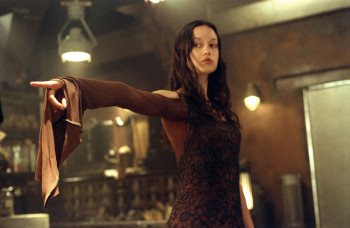Watching Off-Center:
Joss Whedon's Firefly and Serenity

There's no news —
there's the truth of the signal.Mr. Universe
in Serenity
In the hands of Joss Whedon and his creative team, film is a richly thick signal indeed.
I want to suggest a pastime that I've found rewarding, especially so with Joss Whedon's science-fiction television / DVD series Firefly and its big-screen sequel Serenity. After viewing Serenity a couple of times on the big screen of a movie theater, in subsequent visits I experimented with deliberately looking away from the main focus of the moment.In fact this is invited by the presentation of the Firefly / Serenity universe as well as by its richness: Whedon himself directs our cinematic view mostly through outsiders' minds and eyes. We usually see the spatial-cultural 'verse through the perceptions of Serenity's crew; while River's own frequent viewpoint tends to be off-center even to those fringe folk, since she is with the crew without being quite of it. In the movie Serenity, Mr. Universe shows us "the truth of the signal" versus the managed "puppet theater" of broadcast and displayed news.
Let's consider three off-center or background zones for our attention: faces; the spaceship; and cities.
In other words, if a charged conversation between Mal and Inara is the basis of a scene, usually the expressive faces of Mal and Inara are what the director particularly wants to show you. Naturally we want to enjoy that. But another time, try looking off-center, peering past these two figures. Perhaps you'll catch Jayne or Wash or Kaylee in the background, unobtrusively displaying their own glee or concern in the eddies alongside the central theme. Or perhaps Mal is seriously arguing with Jayne or some less sophisticated bad guy; while off to the side we may glimpse Zoe's wary expression, or her gun hand moving nearer her holster.
Another off-center angle: the Firefly-class spaceship Serenity is full of lovingly crafted detail. It's not too much to call the ship the tenth character of the crew. Try looking at any corner of the screen to see what's there: instruments, engineering, homely furnishings. Many of these never have the time or chance to be center stage because they're not pinned into the main-sequence of the plot. Yet they add a lot of lived-in depth to Firefly, making it a local habitation for the crew, and a name they (and we) come to love.
And one more. Whedon's cityscapes are packed with detail: people, costumes, buildings; day-to-day social, commercial, entertaining, and venal activities. The street scenes are wonderful, the business interiors scarcely less so. Look in the corners. Who else is walking along the street, and carrying what? Who is sitting quietly at table, unnoticed — until the Unification Day brawl starts?
I haven't mentioned here the joys of appreciating the Firefly spectrum, the music, the social milieu — See the essays in Jane Espenson's fine anthology, Finding Serenity: Anti-Heroes, Lost Shepherds and Space Hookers in Joss Whedon's Firefly.
Clearly watching off-center is not for the first time we see a television show or movie. If the pace is fast, you won't have time, nor want to. Even on re-viewings, it's not easy. Successful directing certainly guides you to concentrate on the stellar main sequence and its current focus.
Watching off-center works better on a big theater screen, but repeated DVD viewings can give you ease and incentive to study the corners. With the DVD, you can even back up to verify odd and interesting points. But again, not the first time nor perhaps even the second.
Of course you can do this off-center trick with any favorite you're re-watching. Whedon's own Buffy the Vampire Slayer series has some neat extra details, as do many of the more-thoughtfully made films. You can enjoy some of the same effect in a live stage-play or opera that you know well, but not nearly so much as in a packed film.
So watching off-center is rather analogous to reading slowly: or close reading of a book. If a work of art has a richness of signal, take some time to notice the people alongside, the doors and furniture, the side streets: all the muted instruments in any given scene. There always seems to be something fresh to see (and hear) in the superbly rich signal of Firefly and Serenity.
© 2008 Robert Wilfred Franson
| Troynovant, or Renewing Troy: | New | Contents | |||
| recurrent inspiration | Recent Updates | |||
|
www.Troynovant.com |
||||
|
Feature Films: Queen Mab's ride |
||||
| Personae> | Strata | Topography |
|
|||